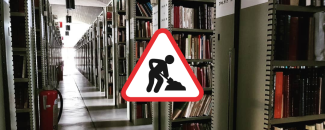Due to major renovation work at the remote storage on the Sart Tilman campus, services such as loan of documents, provision for consultation and partial scanning of documents stored at the remote reserve will be interrupted on Tuesday 20 and Wednesday 21 February. Services should resume on Thursday 22 February.
Please excuse us for this inconvenience.
Renovation work at the remote storage
What are the objectives of the project?
The ULiège Library remote storage is currently being renovated. This remote storage area, the first building on the Sart Tilman site, was designed in 1965 by architect Charles Vandenhove. A 22-month renovation project has just got under way, which is essential to bring the building into line with current energy and safety standards.
The renovation is designed to respect the building's original architectural, technical and heritage features and qualities, as well as its purpose, since it is ULiège Library's largest document repository, including a section dedicated to rare and/or antique documents. The remote storage alone contains more than 39 linear kilometres of documents, almost half of ULiège Library's collections.
What are the (possible) impacts of this renovation?
As a result of these works, and in particular the electrical works, services such as document lending, availability for consultation and partial digitization may be temporarily suspended. If this is the case, you will be notified as soon as possible to minimize any inconvenience.
What's next?
This renovation project will see shelving reinstalled in an area of the building that has been unused for several years, following an incident of fungal contamination. Once the collections there have been disinfected, they can be borrowed again and/or consulted (by making a reservation in the catalogue).
The installation of ventilation and better temperature control will improve document conservation conditions.
The office area will also be completely reconfigured, enabling a series of stages in the process of integrating, processing, circulating and digitizing collections on demand to be carried out directly from the building. These improvements should ensure greater fluidity and efficiency in the future.
